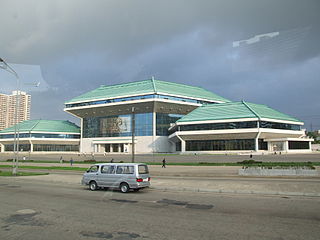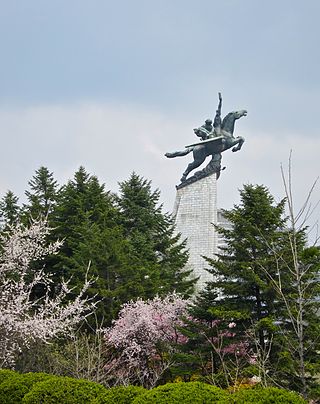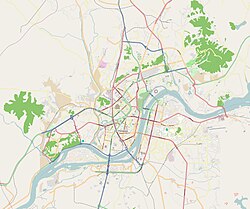
The contemporary culture of North Korea is based on traditional Korean culture,but has developed since the division of Korea in 1945. Juche,officially the Juche idea,is the state ideology of North Korea. Juche displays North Korea's cultural distinctiveness as it is the origin and sole adopter of the ideology.
The music of North Korea includes a wide array of folk,popular,light instrumental,political,and classical performers. Beyond patriotic and political music,popular music groups like Pochonbo Electronic Ensemble and Moranbong Band perform songs about everyday life in the DPRK and modern light pop reinterpretations of classic Korean folk music. Music education is widely taught in schools,with President Kim Il Sung first implementing a program of study of musical instruments in 1949 at an orphanage in Mangyongdae. Musical diplomacy also continues to be relevant to the Democratic People's Republic of Korea,with musical and cultural delegations completing concerts in China and France in recent years,and musicians from Western countries and South Korea collaborate on projects in the DPRK.

Pyongyang International Airport,also known as Pyongyang Sunan International Airport,is the main international airport serving Pyongyang,the capital of North Korea. It is in the city's Sunan District. The airport was closed to international travel in 2020 because of the COVID-19 pandemic,and reopened in 2023 with the resumption of Air Koryo flights to Beijing and Vladivostok.

The Koryo Hotel is the second largest operating hotel in North Korea,the largest being the Yanggakdo Hotel. The Ryugyong Hotel is larger than both,but is not yet operating. The twin-towered Koryo Hotel building is 143 metres (469 ft) tall and contains 43 stories. Erected in 1985 under Kim Il Sung,it was intended to "showcase the glory and strength of the DPRK."

The Yanggakdo International Hotel is the largest operating hotel in North Korea,pending the completion of the Ryugyong Hotel,and the country's seventh- or eighth-tallest building. The hotel is located on Yanggak Island in the River Taedong,two kilometres (1.2 mi) to the south-east of the centre of Pyongyang,the nation's capital. It rises to an overall height of 170 metres (560 ft) and has a slowly revolving restaurant on the 47th floor.

The Chongnyon Hotel is a hotel located in the Mangyongdae District of Pyongyang,the capital city of North Korea. It was opened on May 1,1989 and is situated on the junction of Chongchun Street and Kwangbok (Liberation) Street.
The Isang Yun Orchestra is a Western-style chamber orchestra in North Korea. Named after the composer Isang Yun,the orchestra is attached to the Isang Yun Music Institute in Pyongyang.
Koryo Tours is an independent British tour operator based in Beijing,specializing in group and private tourism to North Korea. Their tours run throughout the year covering budget to exclusive trips. There are packages for staying in the capital Pyongyang with visits to the DMZ at the border with the Republic of Korea. At different times of year there are other events such as the Mass Games and the Pyongyang International Film Festival which are available as special tours when they are running.

The Party Founding Museum is a museum located in the Central District of Pyongyang,North Korea,on the south side of Mt. Haebang. The building was constructed by the Japanese occupation government in 1923. It was used as the South P'yŏngan Provincial Products Exhibition. Thus,in October 1970 it was turned into a museum dedicated to his exploits. Nearby,and also part of the museum,is the modest house he inhabited during his early days as president of North Korea.

The Pyongyang Circus is a multi-function building located in Pyongyang,North Korea. It was completed in 1989.
The Kaesong Chomsongdae Observatory is located in Songak-dong,Kaesong,North Korea. It was an astronomical observatory during the Koryo period. Now only a granite platform remains,the sides of which coincide with the main cardinal points.

Upon its liberation in 1945 and subsequent foundation in 1948,North Korea adopted national symbols distinct from the national symbols of South Korea. The traditional flag of Korea,the Taegukgi,and the symbol Taeguk,were swapped for socialist symbols.

The Monument to Party Founding is a monument in Pyongyang,the capital of North Korea.

The Chollima Statue (Korean: 천리마동상) is a monument on Mansu Hill in Pyongyang,the capital of North Korea. The monument symbolizes the "Chollima speed" of the Chollima Movement. The legendary winged horse Chollima depicted by the monument is said to travel 1,000 ri (400 km) a day.

The Pyongyang Maternity Hospital is a maternity and teaching hospital in Pyongyang. Nurses and midwives are educated in the hospital for work outside the North Korean capital. There is a neonatal intensive care unit at the hospital. In addition,there are multiple different wards,such as dental and breast cancer wards,to treat mothers' various health problems.

The April 25 House of Culture is a theatre located in Pyongyang,North Korea. It was built in 1974–1975 to provide a venue for military education,and was originally called the February 8 House of Culture. It is located on Pipha Street in the Moranbong District of Pyongyang. The classically colonnaded building is considered one of the best examples of 1970s socialist monumentality in North Korea,the other being the visually similar Mansudae Art Theatre.

The Korea Stamp Museum is a postal museum in the Central District of Pyongyang,North Korea.













